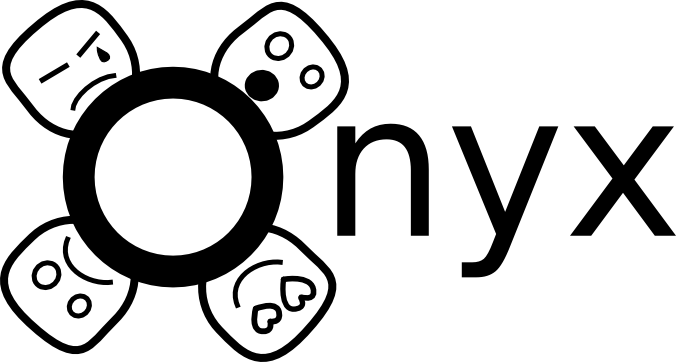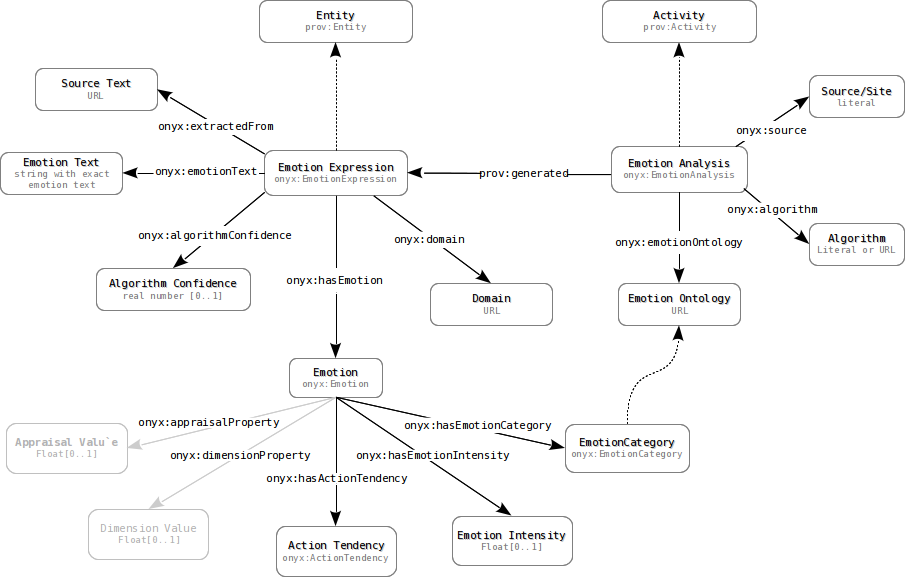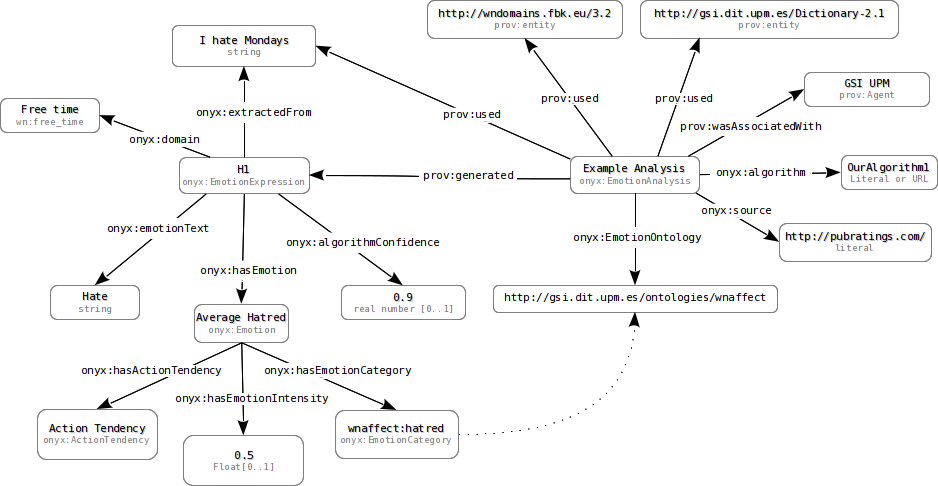

Onyx Ontology Specification
V1.2 - 18 July 2013
- Introduction
- Onyx ontology at a glance
- Onyx ontology overview
- Cross-reference for Onyx classes and properties Classes and Properties
- document wide sentiment analysis
- sentence sentiment analysis
- feature-based sentiment analysis
- enable to publish raw data about emotions in user-generated content
- deliver schema that will allow to compare emotions coming from different systems (polarity, topics, features)
- interconnect emotions by linking them to contextual information expressed with concepts from other popular ontologies or specialised domain ontologies
- Added EmotionCategory
- Added EmotionIntensity
- Renamed EmotionResult to EmotionExpression
- Added properties to comply with EmotionML
- Renamed Emotion to EmotionResult
- Added Emotion class
- Moved emotion type to the Emotion class
- First version of the document
| This version: | RDF/XML, HTML) |
| Latest version: | http://gsi.upm.es/ontologies/onyx |
| Previous version: | http://gsi.upm.es/ontologies/onyx/1.1 (RDF/XML, HTML) |
| Editors: | J. Fernando Sánchez-Rada |
| Authors: | J. Fernando Sánchez-Rada |
| Contributors: | See acknowledgements |
This work is licensed under a Creative Commons Attribution License. This copyright applies to the Onyx Ontology Specification and accompanying documentation in RDF. This ontology uses W3C's RDF technology, an open Web standard that can be freely used by anyone.
Abstract
Onyx is a standardised data schema (also referred as "ontology" or "vocabulary") designed to annotate and describe the emotions expressed by user-generated content on the web or in particular Information Systems. The following document contains the description of the ontology and instructions on how to connect it with descriptions of other resources.
Table of Contents
Appendixes
1 Introduction
The following specification is a formal description of metadata schema proposal that can be applied to emotions extracted from user-generated content on the Web. The goal of the following section is to provide the basic knowledge to comprehend the technical part of the specification. As such it shall introduce both Semantic Web and general topic of opinion representation and sentiment analysis.
Onyx aims to complement the Marl Ontology by providing a simple means to describe emotion analysis processes and results using semantic technologies.
1.1 Opinions on the Web and the opinion mining process
With the birth of Web 2.0 users started to provide their input and create content on mass scape about their subjective opinions related to various topics (e.g. opinions about movies). While this kind of content can be very beneficial for many different uses (e.g. market analysis or predictions) it's accurate analysis and interpretation has not been fully harnessed yet. Information left by the users is often very disorganised and many portals that enable user input leave the user added information unmoderated.
Opinion mining (often referred as sentiment analysis) is one of the attempts bring order to those vast amounts of user generated content. The domain focuses to analyse textual content using special language processing tools and as output provides a quantified judgement of the sentiments contained in the text (e.g. if the text expresses a positive or negative opinion).
Due to the complexity of the problem and attempts to provide efficient and fast tools the area can be divided into three main research directions:
In relation to the World Wide Web, there is a number of common uses of opinion formalisation and analysis. Firstly, it can be applied on top of search engines to find the desired content and next run it through opinion analysis software to obtain desired statistics (e.g. Swotti). Secondly, such algorithms can used within dedicated systems that use the Web to connect to particular communities and gather their opinions on very specific topics (e.g. Internet shops or review websites).
In relation to the dedicated systems (e.g. Enterprise Systems), there the community collaborative models that have proven successful in the open web are often transferred to large enterprise to enhance knowledge exchange and bring the employees together. The same opinion mining techniques can be applied in such cases to extract particular information and use it for internal statistics and to improve knowledge search across the enterprise (e.g. see use of opinion mining in Idea Management [link]).
1.2 The Semantic Web
The Semantic Web is a W3C initiative that aims to introduce rich metadata to the current Web and provide machine readable and processable data as a supplement to human-readable Web.
Semantic Web is a mature domain that has been in research phase for many years and with the increasing amount of commercial interest and emerging products is starting to gain appreciation and popularity as one of the rising trends for the future Internet.
One of the corner stones of the Semantic Web is research on inter-linkable and interoperable data schemas for information published online. Those schemas are often referred to as ontologies or vocabularies. In order to facilitate the concept of ontologies that lead to a truly interoperable Web of Data, W3C has proposed a series of technologies such as RDF and OWL. Onyx uses those technologies and the research that comes within to propose an ontology for the particular goal of describing opinions and linking them with contextual information (such as opinion topic, features described in the opinion etc.).
1.3 What is Onyx for?
The goals of the Onyx ontology to achieve as a data schema are:
2. Onyx ontology at a glance
An alphabetical index of Onyx terms, by class (concepts) and by property (relationships, attributes), are given below. All the terms are hyperlinked to their detailed description for quick reference.
Classes: | ActionTendency | Emotion | EmotionAnalysis | EmotionCategory | EmotionExpression |
Properties: | algorithm | algorithmConfidence | appraisalProperty | dimensionProperty | emotionText | extractedFrom | hasActionTendency | hasEmotion | hasEmotionCategory | hasEmotionIntensity | source | sourceText |
3. Onyx ontology overview
The Onyx class diagram presented below shows connections between classes and properties used for describing opinions.

3.1. Example
A very basic example below shows a single opinion annotated with Onyx metadata:

4. Cross-reference for Onyx classes and properties
Below see a comprehensive list of all Onyx classes, properties and their descriptions.
Classes and Properties (full detail)
Classes
Class: onyx:ActionTendency
ActionTendency -Action Tendency of the emotion: a desire to behave in select communicative or important actions that are connected to a particular feeling.
| Status: | unknown |
|---|---|
| Used with: | hasActionTendency |
[#] [back to top]
Class: onyx:Emotion
Emotion - Class that represents emotions in a generic way| Status: | unknown |
|---|---|
| Properties include: | hasEmotionIntensity hasEmotionCategory |
| Used with: | hasEmotion |
[#] [back to top]
Class: onyx:EmotionAnalysis
EmotionAnalysis - The action of analysing the sentiment in an entity. It produces an onyx:emotion| Status: | unknown |
|---|---|
| Properties include: | algorithm source |
| Sub class of | http://www.w3.org/ns/prov#:Activity |
[#] [back to top]
Class: onyx:EmotionCategory
EmotionCategory - Class that represents an emotion category (anger, happiness, etc.)| Status: | unknown |
|---|---|
[#] [back to top]
Class: onyx:EmotionExpression
EmotionExpression - Describes the concept of emotion expressed in a certain text.| Status: | unknown |
|---|---|
| Properties include: | extractedFrom algorithmConfidence domain hasEmotion emotionText |
| Sub class of | http://www.w3.org/ns/prov#:Entity |
[#] [back to top]
Properties
Property: onyx:algorithm
algorithm - The algorithm used in the Sentiment Analysis.| Status: | unknown |
|---|---|
| Domain: | EmotionAnalysis |
[#] [back to top]
Property: onyx:algorithmConfidence
algorithmConfidence - A numerical value that represents the accuracy of result as estimated by the algorithm itself (. how much the emotion matches a gives object/product).| Status: | unknown |
|---|---|
| Domain: | EmotionExpression |
| Range: | xsd:float |
[#] [back to top]
Property: onyx:appraisalProperty
appraisalProperty - Parent for appraisal properties.| Status: | unknown |
|---|---|
[#] [back to top]
Property: onyx:dimensionProperty
dimensionProperty - Property to be used as parent property of every dimension.| Status: | unknown |
|---|---|
| Range: | xsd:float |
[#] [back to top]
Property: onyx:emotionText
emotionText - The exact text extract that expresses the emotion. This can be used when entity/text pointed by extractedFrom contains many emotions. For example extractedFrom can point to a comment that contains many emotions about a movie, each emotion should have a separate onyx:Emotion and optionally an emotionText property to indicate the specific text fragment of the comment.| Status: | unknown |
|---|---|
| Domain: | EmotionExpression |
[#] [back to top]
Property: onyx:extractedFrom
extractedFrom - Indicates the text from which the emotion has been extracted.| Status: | unknown |
|---|---|
| Domain: | EmotionExpression |
| Inverse property of | the anonymous defined property with the label 'hasEmotion' (Object Property) |
| Has inverse property | hasEmotion |
[#] [back to top]
Property: onyx:hasActionTendency
hasActionTendency - Action tendency of the Emotion.| Status: | unknown |
|---|---|
| Domain: | onyx:Emotion or owl:Thing |
| Range: | ActionTendency |
[#] [back to top]
Property: onyx:hasEmotion
hasEmotion - Indicates that a certain text has a subjective emotion expressed in it.| Status: | unknown |
|---|---|
| Domain: | EmotionExpression |
| Range: | Emotion |
| Inverse property of | the anonymous defined property with the label 'extractedFrom' (Object Property) |
| Has inverse property | extractedFrom |
[#] [back to top]
Property: onyx:hasEmotionCategory
hasEmotionCategory - Value that represents the type of emotion.| Status: | unknown |
|---|---|
| Domain: | Emotion |
[#] [back to top]
Property: onyx:hasEmotionIntensity
hasEmotionIntensity - Value that quantifies the intensity of the emotion.| Status: | unknown |
|---|---|
| Domain: | Emotion |
| Range: | xsd:float |
[#] [back to top]
Property: onyx:source
source - Source from which the emotion was extracted (URL, Site, Entity...)| Status: | unknown |
|---|---|
| Domain: | EmotionAnalysis |
[#] [back to top]
Property: onyx:sourceText
sourceText - Optional value that contains the text from which the emotionText was taken.| Status: | unknown |
|---|---|
[#] [back to top]
A Changelog
2013-07-17
2013-06-27
2013-05-10
B Acknowledgements

This documentation has been generated automatically from the most recent ontology specification in OWL using a python script called SpecGen. The style formatting has been inspired on FOAF specification.
Special thanks for support with ontology creation and research to: Prof. Carlos A. Iglesias and members of the GSI Group of DIT department of Universidad Politécnica de Madrid.
This ontology has been modified and updated to be used in the EUROSENTIMENT Project
